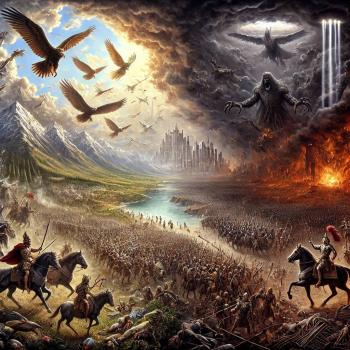The Bible predicts many things that must occur prior to the end of the age and thus before Jesus returns. The following is a list of some of these prophecies with their references in brackets. The first few have occurred since the first century. But many of these still unfulfilled prophecies show that Jesus could not have returned soon at any time after the temple in Jerusalem was destroyed, in AD 70.
- The Christian gospel is preached throughout the entire world (Matt. 24.14/Mark 13.10)
- The church becomes the world’s largest religion (Matt. 13.31-32; Mark 4.30-32)
- The Jews are dispersed throughout the world (Lev 26.33; Deut. 4.27; 28.64-65; Luke 21.24)
- The rise of anti-Semitism in Gentile nations where Diaspora Jews live (Deut 28.37)
- The incomparable suffering of the Jewish people (Lev 26; Deut 28)
- The land of Israel lies desolate a long time to enjoy its Sabbaths (Lev 26.33-34, 43)
- The Jews return to their ancestral land to reestablish their nation (Eze 38.8)
- Ten kingdoms become the world’s last empire (Dan 2.42; 7.7, 20; Rev 13.1; 17.3, 7, 12, 16)
- The literal city of Babylon becomes the world’s greatest city (Rev 18)
- The world’s financial center is located in the city of Babylon (Zech 5)
- The final apostasy sets in (Dan 8.23; Hos 14.4; Matt 24.12; 2Thes 2.3; 1Tim 4.1; 2Tim 3.1-5)
- The final Antichrist arises as first a political and then a religious figure (2 Thes 2.4; Rev 13.3-4)
- The Antichrist subdues three of the ten kings in his rise to power (Dan 7.8, 20, 24)
- The Antichrist becomes the head of the ten-nation, revived Roman Empire (Rev 17.12-13, 17)
- Israel rebuilds its temple at Jerusalem and reinstitutes its animal sacrificial system (Dan 8.13-14)
- The Antichrist makes a covenant with Israel (Dan 9.27; 11.30-32; Hos 12.1)
- The Antichrist gains authority over the entire world (Dan 7.23; Rev 13.7)
- The world worships the Antichrist as a god (Dan 11.36-37; 2 Thes 2.4; Rev 13.4, 8, 12)
- The Antichrist breaks covenant, desecrates sanctuary, stops sacrifice (Dan 8.11; 9.27; 11.31; 12.11)
- The abomination of desolation, the Antichrist’s image, is set in the temple (Deut 31.29; Rev 13.14)
- The Antichrist declares war on the saints, resulting in the tribulation (Dan 7.21, 25; Rev 12.17; 13.7)
- God makes Antichrist lead nations’ armies to destroy Israel (Eze 38-39; Joel 3.2, 12; Zech 12.3; 14.2)
- The nations’ primitive weapons require previous disarmament of conventional weapons (Eze 38-39)
- Jews go to Jerusalem’s temple, repent, and pray God delivers (2 Chr 7.12-15; Hos 3.5; 5.15—6.1-3)
In the Old Testament, the book of Daniel is preeminent in laying out a chronological framework about the endtimes. But it, like all biblical prophecies, only relates a chronological succession of prophetic events, not their actual timing. To begin, Daniel had a vision about the endtimes in which he was informed that someone “took the regular burnt offering away” and “overthrew the place of his sanctuary” (Dan 8.11). This means that Israel’s animal, sacrificial system will be stopped at its temple in Jerusalem. Later, Daniel had another vision that an angel interpreted for him. He was told, “They shall abolish the regular burnt offering and set up the abomination that makes desolate” (11.31).
In Jesus’ Olivet Discourse, he cited these prophecies by Daniel and warned that when it happens there will follow unprecedented “great tribulation” (Mt 24.21; Mk 13.19; Lk 21.23). Both Daniel and the author of the NT book of Revelation repeatedly make clear that this great period of distress upon God’s people will last three and a half years (Dan 7.25; 9.27; 12.7, 11; Rev 11.3; 12.6, 14; 13.5).
The Apostle Paul wrote to the church at Thessalonica about a false rumor saying, “the day of the Lord is already here. Let no one deceive you in any way; for that day will not come unless the rebellion comes first and the lawless one is revealed” (2 Thes 2.2-3). Paul here alludes to Daniel’s prophecy about a time “when the transgressions have reached their full measure, a king of bold countenance shall arise” (Dan 8.23). So, Paul explains that this “king” will be “the lawless one,” whom Christians later came to call “the Antichrist” (1 John 2.18, 22; 2 John 7). Paul says “he takes his seat in the temple of God [at Jerusalem], declaring himself to be God” (2 Thes 2.4).
The Antichrist will then “make war with the holy ones,” referring to the people that belong to “one like the Son of Man” (Dan 7.13-14, 21; cf. 8.24; 12.7; Rev 13.7). Then “the abomination that makes desolate” will be set up at “the appointed time of the end” (Dan 8.19; cf. 11.27, 29, 35, 40; 12.9). The angel further informs Daniel that there will be three and half years from then until the end of the age (cf. Dan 7.25; 12.7; 8.13-14; 9.27; 12.11-12). Jesus called this period of time “the (great) tribulation” or “distress” that his people will suffer (Matt. 24.15-20; Mark 13.14-19). The book of Revelation also mentions it (Rev 12.6, 14). I think this abomination is a statue of the Antichrist that serves as an idol of him that people must worship or be put to death (Rev 13.14-17; 20.4).
To summarize, the above prophecies clearly show that Jesus cannot return until the great apostasy occurs, the temple is rebuilt at Jerusalem and its sacrificial system re-instituted, the Antichrist appears, he puts a stop to the sacrifices at Jerusalem’s temple, he declares himself as a god, and three and a half years of tribulation ensue to the end of the age. (See a similar post on August 4, 2015, “Why Jesus Cannot Return Soon.”













